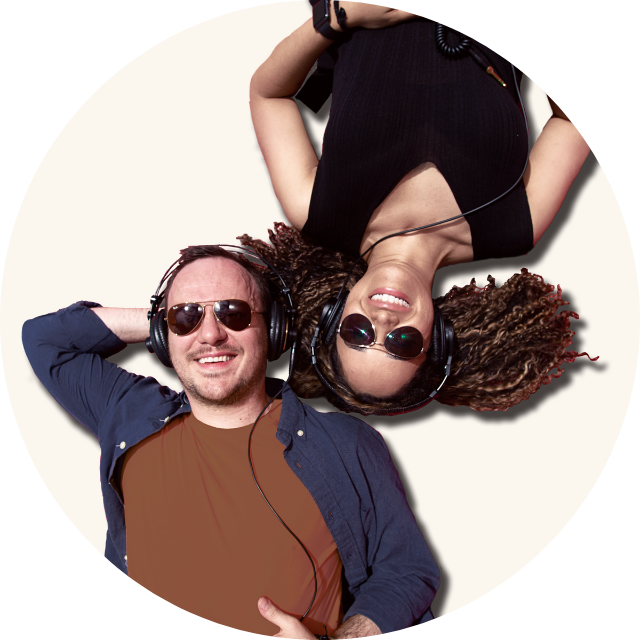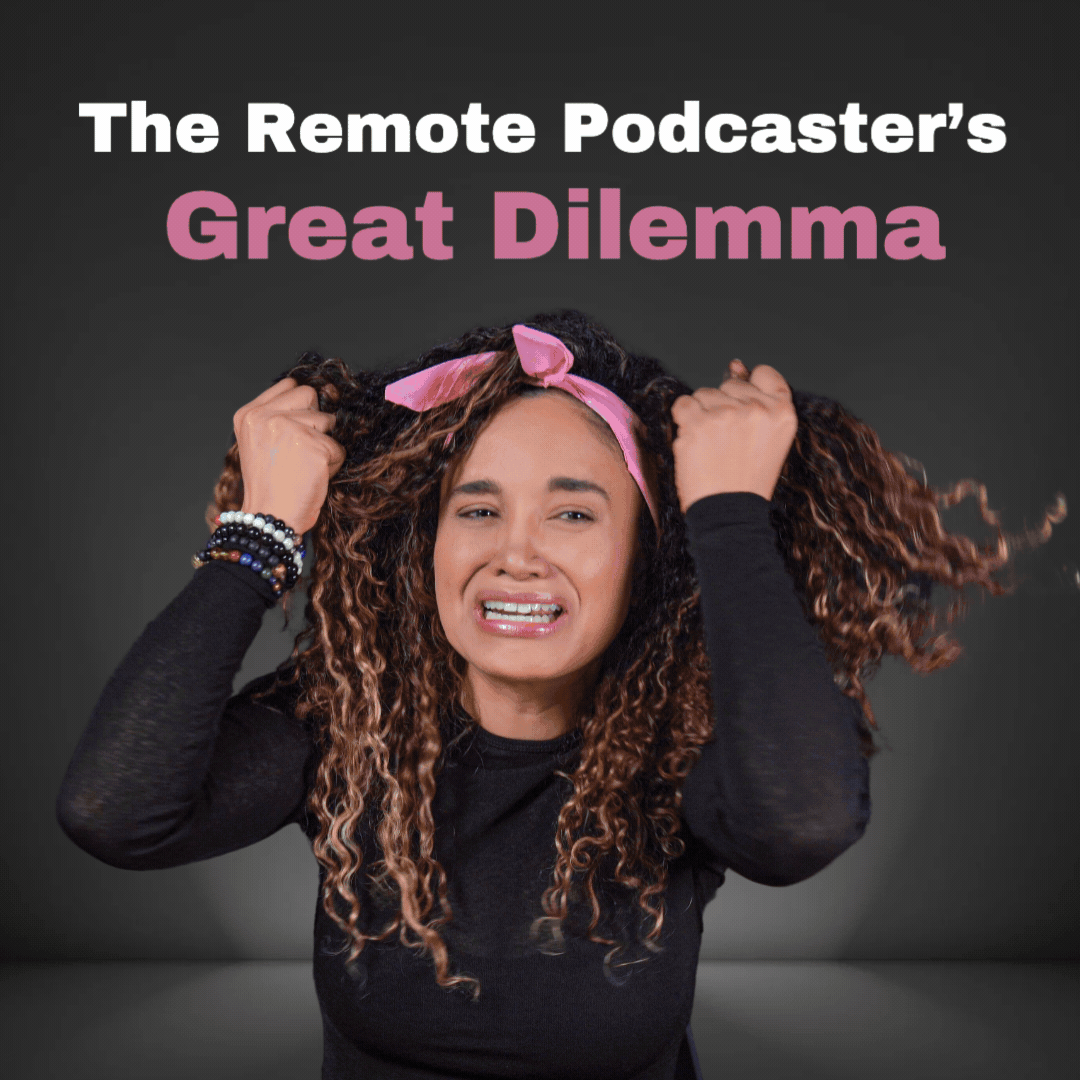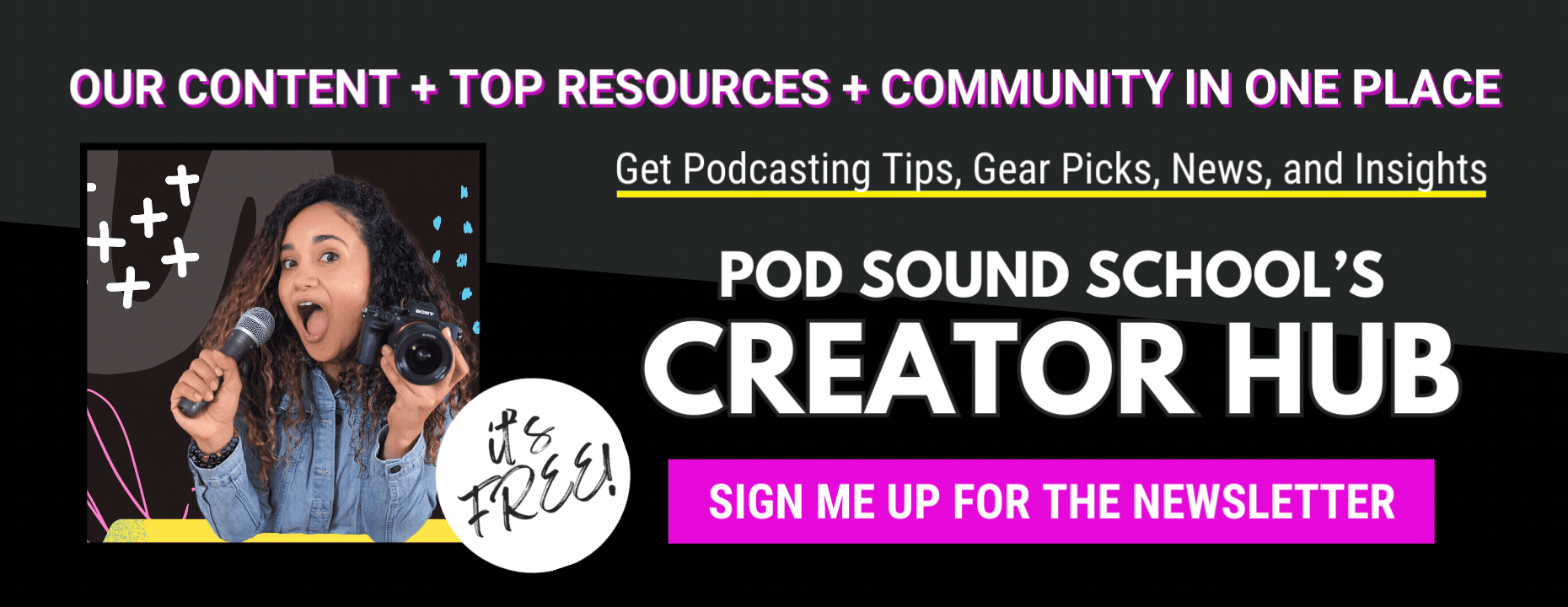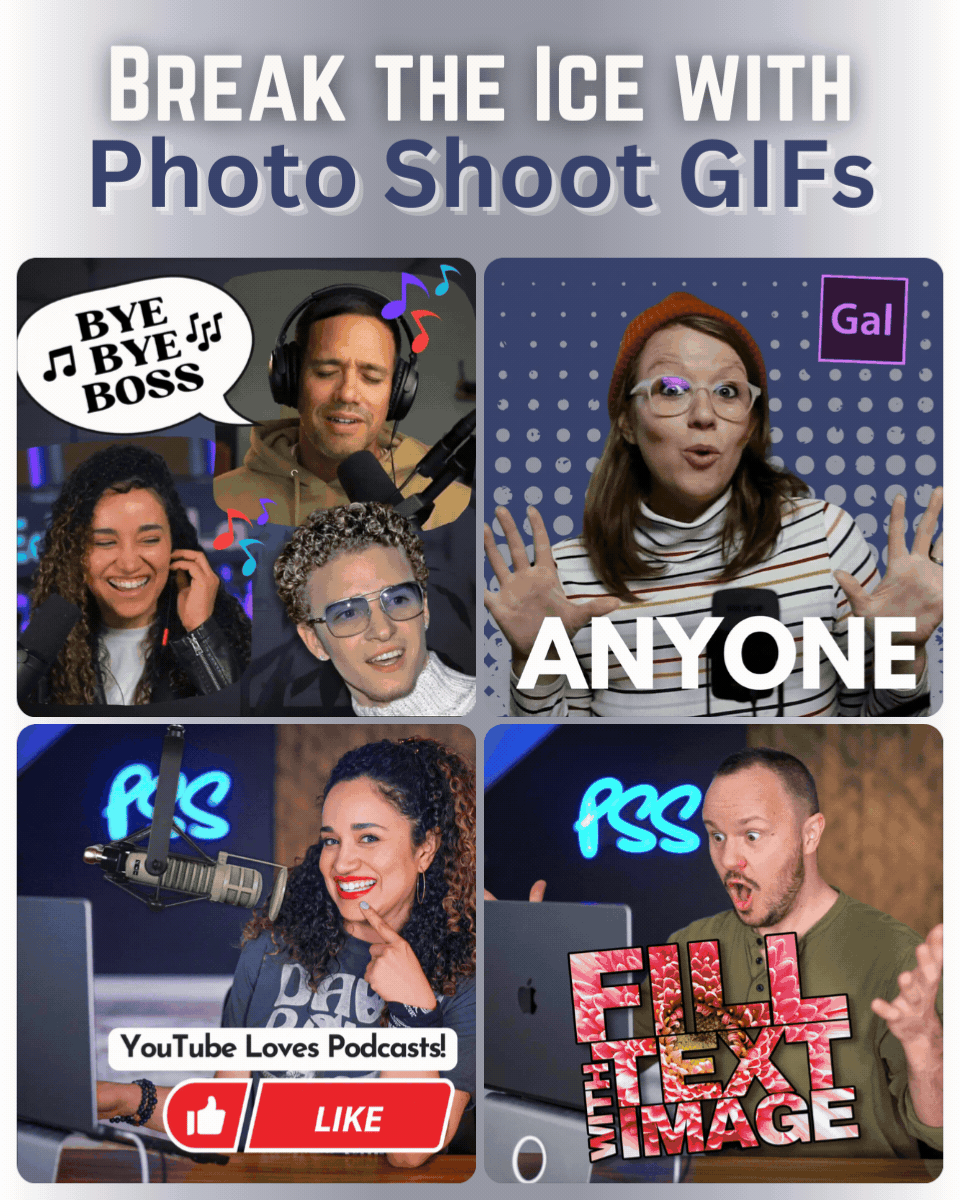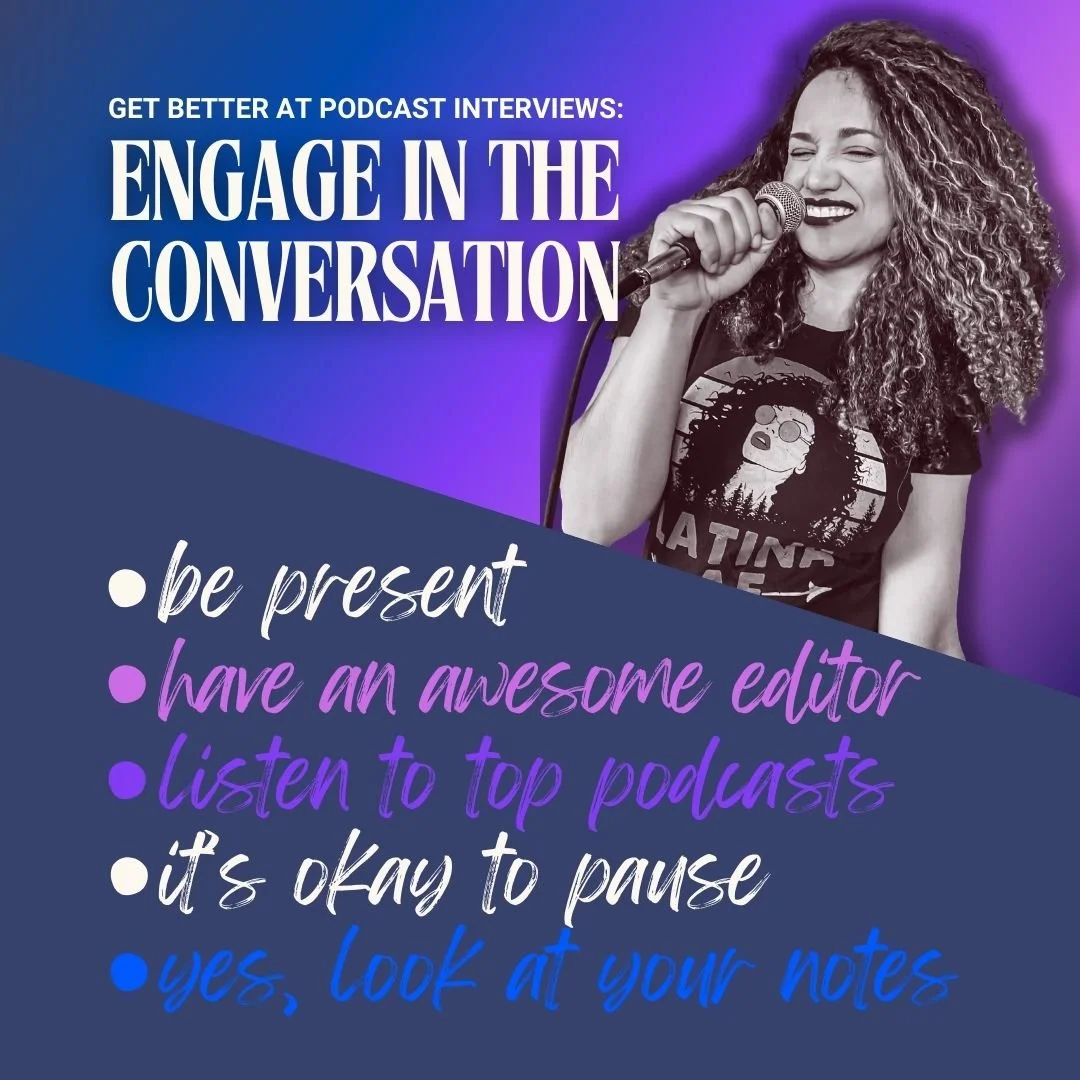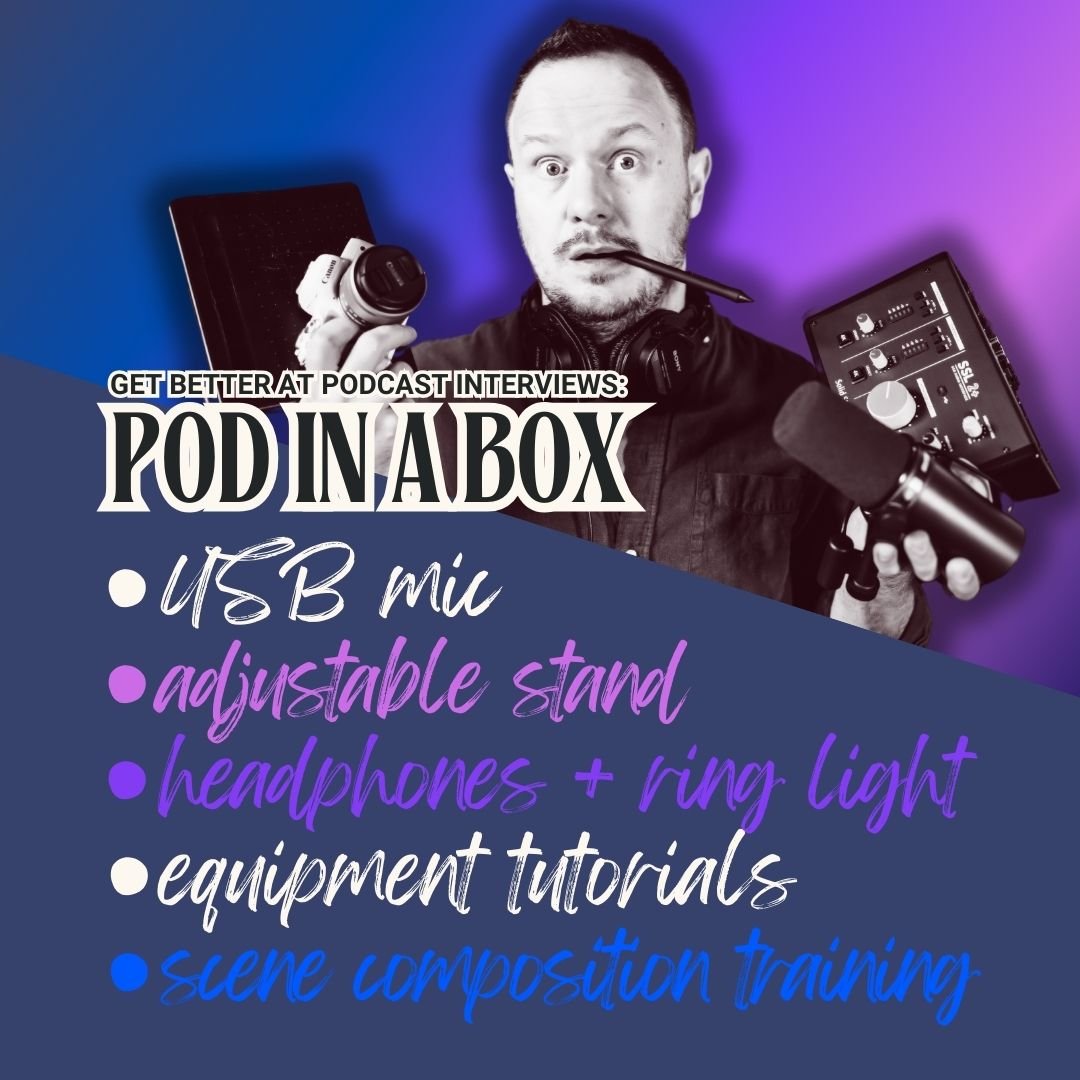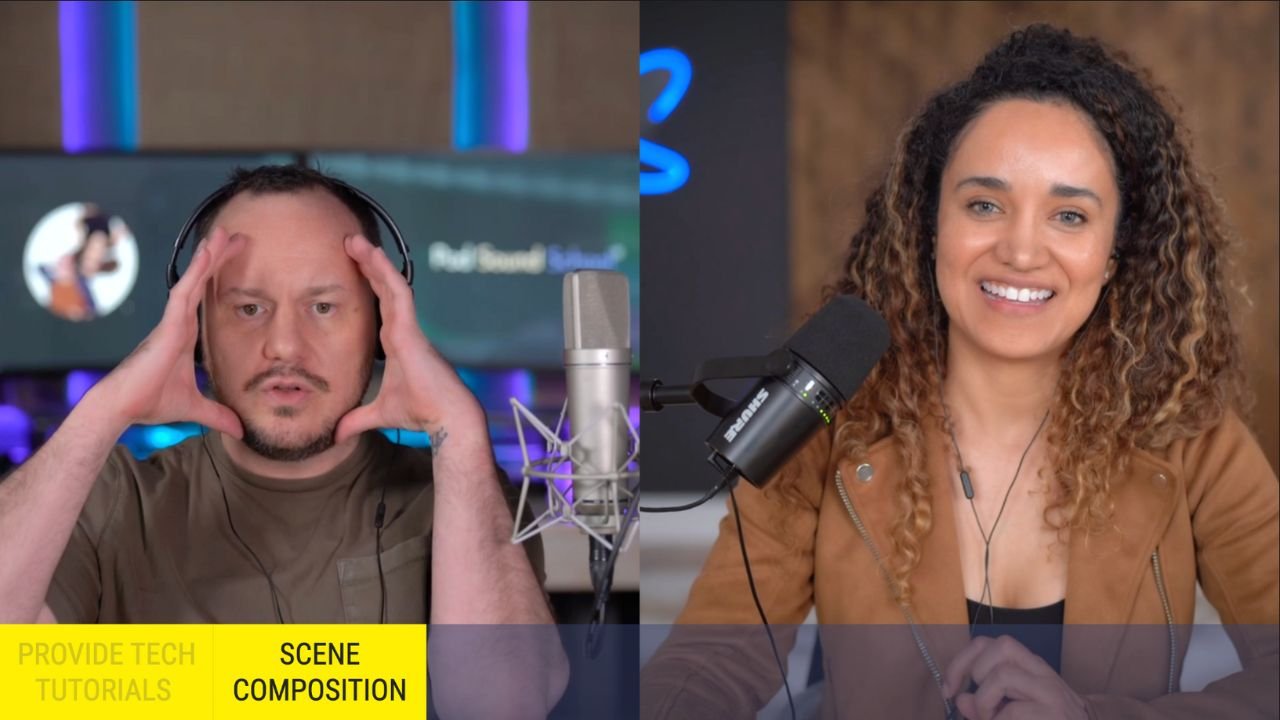Get Better at Podcast Interviews (How to Find Guests, Record, What to Ask)
As an Amazon Associate, Pod Sound School earns from qualifying purchases made through the links provided on this website. This means we may receive a small commission at no additional cost to you if you choose to purchase through these links. Your support helps keep the content coming. Thank you!
One of the biggest problems and pain points that we deal with on a weekly basis as podcast creators is the podcast interview.
In particular, we're not going to be talking about our interview techniques or styles or how to conduct a good interview.
Instead, we're going to talk about:
I know that you are not a stranger to the very typical remote podcast interview we see where…
the host looks great
their background looks great
their camera looks great
they sound great
…BUT the guest looks like SH💩T.
And it hurts the overall episode and makes for an experience that you don't really want to watch or consume and can be difficult.
🎤 So how do we get better recordings from our guests?
🎤 How do we find good-quality guests for our shows to begin with?
🎤 What are some podcast interview hosting best practices?
You are in the right place because we are dedicated to helping you make better content so you can get a bigger ROI on your efforts.
But before we start, if this is your first time here, welcome to the Pod Sound School!
I'm Studio Steve, a graphic designer, video and audio producer, and instructor at Pod Sound School with about 20 years of experience in professional audio production.
And I’m Veronica, Pod Sound School’s content director, marketer, and strategist, specializing in crafting authentic and engaging content that connects with audiences and drives tangible results.
And yes, we created this blog post together because it’s based on our YouTube video here.
To learn more about how podcasting can help you grow your business, get our top video podcasting hacks and gear picks, and stay up to date on the latest news, click here to subscribe to Pod Sound School’s FREE Creator Hub Newsletter.
PART 1: HOW TO FIND GOOD-QUALITY GUESTS (WORK ON YOUR PITCH)
In part one, we're going to tackle “work on your pitch” because this is crucial when it comes to reaching out to and finding quality guests for your podcast.
Within your pitch to find a great guest for your show, you have the opportunity to do some very important communication.
Let’s talk about the pitch and break down the process into key components to help you connect with potential guests effectively.
1. Keep It Human and Personal
For your pitch, you want to make it simple. You want to use language that you would use when you are reaching out to another human.
Don't use ChatGPT.
You can use ChatGPT to:
help you with the format
help you flesh out the main points
do your research on the person you want to interview
direct you to difficult-to-find resources
You can use ChatGPT for those things but don't ask ChatGPT to write your pitch and send it like that…
…because we're getting very smart at identifying communication — like email, text, and DMs — that is totally written with ChatGPT.
Avoid sending a message that feels automated if you want that person to reply.
Instead, infuse your email with your personality and a personal touch. Address the potential guest as an individual, not just another contact.
2. Leverage Connections
Something important that we have had issues with both while getting pitched to and pitching to people to be guests on Content Jefe is the importance of having somebody to connect you to that person.
When you are doing a cold pitch, the chances of that person telling you no are higher. I have cold-pitched to a few people and two of them said no to me.
On the other hand, when you are referred or connected or introduced by somebody else in the industry, somebody else who knows you and knows the person you’re pitching, the chances of that person saying yes are higher because you are being recommended.
GET LINKED: This is a good way for you to get a yes.
3. Craft a Strong Subject Line
As far as the structure of your pitch, the email subject line is the piece that’s going to get your email noticed and opened — you definitely want to spend time thinking about it.
Your email subject line can be as simple as:
"I want you to be a guest on my podcast"
"Podcast Guest Invite"
Your email subject line should:
Be straightforward
Say what the email is about
Clearly state what you want
If the person is interested, they will open that email, read through the entire email, and decide whether or not your show is a good fit for them.
Even potential guests who have hundreds of emails in their inbox will check the subject lines and at least star the email to look at it later if it says “podcast guest invite” because they're going to go check out your podcast.
We're all looking for podcasts to be on and most people don't actually get invited on podcasts enough. So, crafting a strong subject line is very important!
4. Include All the Details
Inside your guest pitch, include all of the details about:
your audience
your show
the value proposition of your show
for how long
all of the strong points of your podcast
ARE YOU A NEW PODCAST HOST?
If you've been producing your podcast just for a couple of weeks, don't talk about being so new, rather you can talk about:
your mission
the value proposition of your show
the experience that you bring to the table
your audience
or the audience that you want to reach
how that person is the right fit for your audience and why
This will make it so you highlight the best parts of the podcast without sharing data or information that may increase the chance of that person saying no, turning it into an opportunity missed for them and you.
So think about that.
5. Be Concise and Clear
Make your pitch concise and clear. I have issues with this because I like to give long-winded answers to pretty straightforward questions.
And I do the same with my emails. I like to throw things in there, but maybe I should be more careful about “killing my darlings.”
So be concise and clear, however, be personable. You want to connect with the other human who will be receiving that email or who will be receiving that DM.
Insert as much of your personality and flavor into it without making it too long.
6. Show Genuine Interest
Don't send just a generalized email inviting people to be on your show and that's it.
Always be genuine and show genuine interest in the person, what they have to offer, and his or her expertise.
Do your research and get to know the potential guest.
When you do the research, you may find out that the person is not a good fit for your show so that’s why it's important to do your homework and dig a little deeper.
What you learn about the potential guest will show in your communications.
Let’s say I watched your videos, read your book, and saw you speak on stage. Those are good things to bring up in that very first communication where you're pitching your show to that potential guest.
7. Avoid Templates
When you're looking through someone's content and finding new people to invite onto your show, it can be hard to dig deep and find something that's unique about them.
However, if you keep it simple and talk about their content, that you're a fan of their work and things like that, you can get to know them without doing a tremendous amount of research.
But I know that a lot of people in this realm, and I know we get a ton of these emails where a lot of people will try to sneak in a more systemized approach when trying to look like a fan. It doesn't work that well from our own experience.
For example, they'll say, “I just watched your recent video about (insert subject line here).” It's so obviously a template with placeholders!
Don’t use the placeholder strategy.
When you're looking at their content, ask yourself:
Why do I want this person on my show?
Why would my audience be interested in them?
What is it about them that I love?
And then just articulate those things in your pitch:
“There's (this thing about you I love) and my audience would love you. What do you say? Do you want to be a podcast guest?”
8. Include a Strong Call-to-Action (CTA)
Finally, end your pitch with a strong CTA and think strategically about the links you decide to include in the email.
Be very clear about how they can communicate with you.
Provide instructions and easy ways for the guest to:
check out your show
get in touch with you
schedule their appearance
Including relevant links and contact information helps streamline the process.
With that, we can confidently move on to the second big thing you need to master.
PART 2: HOW TO PROPERLY COMMUNICATE WITH YOUR GUESTS
The second big crucial yet often overlooked thing that will help you get better at hosting podcast guests is effectively communicating with your guests.
This is a huge topic and I really feel like it's one that is so fun and can be very creative.
Yet so many podcast hosts drop the ball with this especially when they’re running the whole show solo, but it's something you’ve got to implement.
If you aren't running the show solo and are working with a PR firm or an assistant who isn't already helping you with some of these communication pieces, make sure you get them involved ASAP and set up a strategy for solid guest communication.
Good communication can make or break the success of an episode, ensuring both host and guest are comfortable and prepared.
1. Provide Detailed Instructions
The first point here is to assume nothing and provide all the details of the interview process:
what they can expect before, during, and after
what they need to do to prepare
Don't assume that people know that they have to show up ready for the camera. They may not know that your podcast is a video podcast.
Don't assume that they have things figured out as far as the technical aspects. Even seasoned podcasters may not be familiar with your specific setup.
It's always a good practice to send detailed instructions.
Platform and Format:
Specify if your podcast is audio-only or includes video.
Clearly state the platform you'll be using to record the interview, whether it's Zoom, Riverside, or another service.
Equipment Requirements:
Outline any equipment that is required or necessary for the interview to be successful such as microphones, cameras, or lighting.
If the guest lacks this equipment, consider providing it to ensure consistency in quality.
Preparation Guidelines:
Share any pre-interview preparation they should do, such as reviewing talking points or familiarizing themselves with your audience.
Don't assume anything. Always provide detailed instructions.
The more you practice clear communication, troubleshoot, and prepare for the day of the interview, the more you will feel confident, your guests will feel confident, and the best the experience will be for both parties.
The coolest aspect is that all of this can pretty much be templatized. Optionally, you can record tutorial-style videos and other general support material that you can easily share with all of your guests.
There's lots of fun stuff you can do here!
2. Address Equipment and Quality Concerns
To maintain a consistent quality across episodes, it’s essential to address any equipment deficiencies in advance.
Supply your guests with a list of equipment they need to get so they can prepare before the interview.
This equipment list may include things like:
a microphone
studio lighting or at least a diva light
a computer that can handle the recording solution
a camera
*If the guest doesn't have the proper equipment, you can send them the equipment. Sending the same pieces of equipment to every guest will guarantee all of your podcast episodes look the same and your content has continuity everywhere online.
*Keep reading to learn more about the “Pod In A Box” concept.
BIGGEST HURDLE FOR VIRTUAL PODCASTERS:
Getting that consistent, good quality from our guests is what I see as being the biggest hurdle for recording remote podcast interviews online.
We can have these amazing platforms like Riverside and SquadCast that do a great job at getting high-quality recordings but recording at the highest quality possible in a scary basement bedroom with no lighting, a bad composition, and a crummy camera is still not going to look good.
They say you can polish a turd, but it's still just a piece of sh💩t.
For example, we have that situation right now with one of our clients. We're doing a podcast makeover with this particular client. And right now we got him to a point where he looks very professional, his studio looks incredible now with lighting and a great camera, but his guests don't look good.
Now we need to train our client or put some videos together for his guests, so they can look and sound great on camera too, or are at least a little bit closer to his quality so it doesn't look like such a sore.
He looks amazing and then there's the guest, and you only see half of their forehead or more of their ceiling than their face and shoulders in the shot.
And that's no fault of the guest really. It’s probably because:
we were too timid to ask them to adjust their camera
we failed to prepare them properly and send them detailed instructions beforehand
both
3. Break the Ice with Warm-Up Activities
Now let’s talk about how to communicate with your guest before you begin the interview.
After you connect with your guest virtually via a platform like Riverside or SquadCast, but before you begin the interview there are several things you can do to create a comfortable environment and engaging environment.
Establishing a good rapport with your guest before the interview begins is paramount.
It's a good thing for you to not jump straight into the interview because podcast interviews can be a little nerve-wracking and all of your insecurities may begin to pop up.
Am I going to…say the right thing…mess up…use proper English…English is my second language…ask the right questions?
What I suggest is that you create an activity that will help break the ice and allow the two of you to warm up to each other.
ACTIVITY #1
So, what I do before the interviews I host is I ask my guest to take a breath with me.
Although it can sometimes seem like a weird thing for your guest to do at least they won’t be bored. It’s like a pattern-interrupt. More importantly, it calms me down and we’re relaxed as we get into the interview.
ACTIVITY #2
One thing that occurred to me is that I might as well ask my guests to do their best YouTube face — because I often interview experts who also have a YouTube channel and they are sitting here with me on camera and this is how I take pictures of my guests to create the thumbnails for each episode on YouTube.
If you don't know the YouTube face, just go to our channel where you see me making all sorts of weird faces.
First, you may need to ask your guest to come closer to the camera. And then ask them to be silly with you or do certain poses.
Let them know that you will be using these pictures to promote the episode on platforms like Instagram and LinkedIn.
Right there you’re breaking the ice, relaxing into the interview, and getting photos of your guest.
Whatever works for you do it but don't jump into that interview with all of your insecurities because it won’t be fun.
The ice breaker photo shoot is just so effective because:
It gives you a bunch of promotional assets for your social media platforms, website and newsletter
It will provide you with a few different poses that you can choose from for your YouTube thumbnail
And you’ll be able to turn the collection of poses into a fun GIF image*
*Check out the instructions and video for how to make an animated GIF image at the bottom of this post.
So it's really smart in terms of workflow and “killing more birds with a single stone.”
It's the icebreaker
It’s the YouTube thumbnail photo for the episode
It’s all the promotional material
4. Encourage Openness and Comfort
Creating a relaxed atmosphere for your guests can lead to more authentic and engaging conversations.
Ways to get your guest in the right zone can include:
Little games
Mini warmup segments
Breathing exercises
Getting silly (can be a fun way to get to know each other)
Anything that you can think of that matches your personality
It’s all about thinking of different ways to be more authentic and show up as your most confident self as the interviewer.
We all have our own stressors that may cause anxiety to flare up during an interview such as English being your second language or the technical stuff that you can’t control perfectly.
That’s why I think it's really helpful to be open about your comfort levels right off the bat and give your guest an opportunity to express to you how they're feeling.
It can be kind of a tricky thing, but one thing you could do as an informal way to gauge how the guest is feeling is say:
“As part of my procedure, I always like to begin with a camera check and sound check to make sure there are no tech issues. Can you talk to me for a minute?”
And then they say, check, check, check, or something.
Use this time to engage in light conversation or address any anxieties they might have. This helps set a positive tone for the interview.
5. Leverage Small Talk
What I love about the “icebreaker photo shoot” is it cuts through what most people probably do before starting the interview: small talk.
The thing that I'd like to advise about small talk is to make sure you press record because that stuff usually contains gems that can be used in the episode.
The other worrisome thing that happens to me all the time with small talk is that you can get derailed and sidetracked and then forget what your episode was even going to be about to begin with.
On the other hand, small talk can also be a good thing because you may learn something new about your guest or uncover an interesting topic that might not have been planned. You can then decide on the fly to take the episode somewhere totally different.
All of these things are very nuanced and take a lot of practice.
While preparation is crucial, being flexible and adaptable during the interview can lead to more genuine and compelling content. If an unexpected topic arises during small talk that seems more engaging, don't be afraid to pivot and explore it further.
PART 3: HOW TO ENGAGE IN THE CONVERSATION
The third big crucial thing that will help you get better at hosting podcast guests is engaging in the conversation and being a good listener in the interview.
It's not just about understanding that we have an audience, being there on behalf of our audience as a spokesperson, and asking the questions they would ask your guests if they had the opportunity. That’s an obvious goal and hopefully, you’re already doing that.
What else can you do and what does it mean to engage in the conversation?
1. BE FULLY PRESENT, CURIOUS, AND EXCITED
Engaging in the conversation means being fully present. It happened to me when I finished a podcast interview and didn’t even remember what I said either because I was nervous or not fully present.
Do you ever catch yourself worrying about:
Am I going to ask the right questions?
Am I going to sound eloquent?
Am I going to sound like I have my shit together?
Am I going to sound like a professional?
Am I going to sound like Larry King?
Am I going to be Joe Rogan?
There's a reason why Joe Rogan is popular and his podcast is so famous. It’s because Joe Rogan doesn't want to be anybody else. He shows up and asks the questions he is curious about, and is Joe Rogan.
So show up as you are with your innate curiosity.
Have a few points you want to touch on so you can use your planned keywords and get the SEO juice for that episode, but it’s equally important to be fully immersed in the conversation and come from a place of curiosity.
Think about this: How exciting is it that you get to sit down with somebody and have their full attention for a whole hour? You can ask them anything related to their authority and expertise, and be broadcast to hundreds, thousands, or millions of people. Who knows what will happen?
Being connected and present allows you to ask follow-up questions when your guest opens up about something significant or when they are opening up and talking about something publicly for the first time.
You may miss those precious gems if you are not present. If you're worried about asking the right questions or sounding eloquent, it can be distracting.
Remember, it's just talking to another human and coming from a place of curiosity and excitement.
2. HAVE AN AWESOME EDITOR
One thing that can also really help with confidence is knowing that you have an editor who has your back.
Plus, you can tell your guests that you have an editor beforehand which will help their mindset tremendously.
You can say, “Hey, if you ever mess up, my editor's name is Wallace and he's awesome. You can just talk to Wallace and say, ‘Wallace, I'm sorry. I messed up. Can we cut that out of the final edit?’”
It's tremendously freeing to know you don't have to be perfect because you have an awesome podcast editor on your team who will catch those mistakes, make us sound more eloquent, and maybe progress the conversation in a way that's more appropriate for the overall story of the episode.
So getting hooked up with an editor is a really sweet thing that can give you and your guest an automatic boost in confidence.
Get yourself a Wallace, a Pod Sound School editor.
Seriously, you'll thank us later.
3. LISTEN TO TOP PODCASTS
Listen to a bunch of podcasts and make notes.
It's about getting yourself out of the consumer mind and into a producer mindset when you're consuming your content.
While you’re listening and watching, make notes…
How do your favorite podcast hosts respond?
Are they good listeners or do they tend to interrupt their guests?
How do they structure their interviews?
How thoroughly do they prepare?
What sort of questions do they ask?
What makes you stay engaged and listen to the end?
4. IT’S OKAY TO PAUSE AND LOOK AT YOUR NOTES
It's perfectly okay to not jump in immediately after your guest finishes their thought.
A lot of times your guest will be finishing a really profound thought and you're trying to pay attention but you're also like, “Holy shit, I've got to come up with another question after this.”
But rest assured, you don’t need to panic because they're okay with helping you work out your thoughts.
It's perfectly okay to say, “Ooo, wow!” and pause.
And again, that also comes with having the confidence from knowing you have an editor who has your back.
It’s your show and you are the interviewer so give yourself permission to take a nice pause to process the thought, look at your notes, and ask a really good follow-up question.
Or to keep it really simple, you can say, “That was incredible! So I have about 20 follow-up questions to that, but I'm going to look at my notes so that we can stay on track.”
Then take a minute and look at your notes. It's fine to do that in a pre-recorded show that will be edited before it’s released to the public at a later date.
Bonus Tip: The 'Pod In A Box' Concept
As a podcaster, you strive to deliver high-quality content to your audience.
THE PROBLEM: As I griped about earlier, the biggest hurdle for a podcast host is getting consistent, good-quality remote recordings from our guests.
🤔 So what can you do?
One effective way to ensure top-notch recordings, especially when working with guests remotely, is by using a Pod In A Box.
What is a Pod In A Box?
The Pod In A Box is a curated set of podcasting equipment you send to your guests. This setup is designed to help your guests quickly and easily achieve a professional recording environment.
Not so surprisingly, many professional virtual podcasters incorporate this into their budget to ensure consistent audio and video quality across episodes.
Why Use a "Pod In A Box"?
Consistent Quality: By providing your guests with the necessary equipment, you ensure that the audio and video quality of your podcast remains consistent.
Ease of Use: A pre-configured setup helps guests who may not be familiar with podcasting equipment to quickly get up to speed.
Professionalism: Sending a "Pod In A Box" shows your commitment to quality and professionalism, making your guests feel valued.
Components of a Pod In A Box
Although we are determined to come up with a done-for-you solution, this is something that you can build yourself.
Create a simple box to send to your guests
Or a list of items they can purchase (in different price tiers)
Or both
Essential Equipment to Include:
1. USB Microphone:
At the very least, include a USB microphone. It’s the cheapest option (especially if you get this one) and doesn’t require an audio interface like XLR microphones.
A high-quality USB microphone on a sturdy, adjustable stand ensures clear, crisp audio.
However, avoid using the dinky default stands that come with most USB microphones because they don't position the mic up high enough so it’s close to the guest's mouth.
Find a desktop stand or a desk clamping stand/arm that's relatively lightweight (for shipping) but that (most importantly) gets the microphone up nice and high so it’s close to your guest’s mouth.
2. Headphones:
It's also a good idea to include some comfortable headphones in the box. Like the microphone, they can also be very cheap.
Comfortable headphones help prevent audio feedback and improve the guest's listening experience.
If you're going to be sending earbuds, you probably want to send new earbuds to each guest because it's disgusting to think about putting somebody else's earwax in your ears.
One of my favorite things in terms of audio, even though it might not look the best on camera, is headsets. Headsets are a great alternative to earbuds.
A headset alone, just for getting a clean audio recording, is an amazing Pod In The Box.
3. Ring Light:
Consider dropping a ring light, a.k.a. a diva light, with a stand or a mini clip-on ring light in your Pod In A Box.
It’s used in the makeup industry all the time because it illuminates the face evenly, eliminating all the shadows and making you look younger and more lively on camera.
Additional Items:
Return Envelope: Include a prepaid return envelope for easy return of the equipment.
Instruction Manual: A simple guide or tutorial video explaining how to set up and use the equipment.
Training and Communication
Preliminary Tutorial Videos:
Create tutorial videos tailored to the platforms you use, such as Riverside.fm or SquadCast by Descript. These videos can guide your guests through the setup process and familiarize them with the recording platform.
It takes two things to get better-quality recordings from our guests. One thing is using high-quality equipment, but the biggest thing is actually communication and training.
Many of your guests won’t have the training, understanding, or practice of podcasting the way podcast hosts do.
This is why it’s so important that you DO NOT ASSUME your guests already know:
what to do
what equipment to use
how to use it
Providing a simple preliminary tutorial video that’s generalized for everyone can really help you get off to the right start.
For example, if you know that you're always going to be using SquadCast by descript or Riverside.fm to record, make a simple tutorial video to guide your guests through the setup process, familiarize them with the recording platform, and show them how you like to use Riverside. Then you’ll be able to send the same video to every guest.
You can even take your training assets a step further and ask your cohost, a friend, or somebody who can join in to help demonstrate what to do on camera and how to use the podcast recording platform and equipment.
While some of your guests might not need to even look at your training assets because they’re podcasters too and already use Riverside every week, other guests will really appreciate it!
Scene Composition:
In combination with technical training, help your guests understand basic scene composition for video recording.
Explain how to:
frame their face properly
avoid low or unflattering angles
ensure their background is tidy and professional
Many people naturally assume our face should be in the middle of the shot because our head is a circle and a circle should go in the middle.
That’s why a LOT of our guests are down here…
When you're thinking about framing and scene composition in a Hollywood film, it’s all about symbolism and creating what you want the audience to feel and think about the characters.
For example, to make a character seem insecure or small, they’re often hunched over and the camera is positioned so that we’re looking down on them.
Whereas to make a character look really powerful, menacing, or overwhelming, the camera will be positioned below them so that we’re looking up at them.
The 2 most common things you're going to see from your guest:
Their head is positioned really low or in the middle of the frame.
2. When they're connected through their laptop, the laptop camera is looking up their nose.
Neither option is a good or flattering look for them.
And I don't think they want to show up on camera looking unprofessional, so we need to open up the conversation about these things — it's the only way around it.
This is why we're so determined to create a simple DFY solution.
Budget Considerations
It might seem crazy to wrap your head around the Pod In A Box concept because you may be thinking, “I'm gonna spend that much?” or “How much money is that gonna be every week?” or “I'm looking at 70 bucks a week, or a hundred, or 200 US dollars a week!”
Investing in a Pod In A Box may seem costly, but there are ways to manage the expenses:
Reusable Kits: Create multiple kits and reuse them by including a return envelope for guests to send the equipment back to you.
Encourage Purchases: If your budget is tight, provide a list of recommended equipment that guests can purchase themselves and a variety of options at various price points.
It’ll be worth it because it’s a really creative way to engage with and warm up your guests while elevating the overall production value of your podcast.
Success Stories and Inspirations
I first heard about the “Pod In A Box” from Zachariah Moreno, the founder of Squadcast, when I was interviewing him.
He talked about a woman podcaster who sends Sennheiser headsets to each guest with a return envelope. He thought it was so genius!
That story inspired the idea of the “Pod In A Box.” So thanks, Zach. And congratulations on the Descript Squadcast merger! 🎉
Stay Tuned
Make sure you stay tuned to our content as we develop training videos and resources to help you implement your own Pod in a Box.
Our goal is to make it super easy for you to:
help get your guests trained via pre-recorded video tutorials
help your guests quickly and effortlessly achieve a pro-level video podcast setup
maintain consistent quality across all your podcast episodes
So give us your ideas here. Tell us what you think about the Pod In The Box and what you'd like us to include in the Pod In The Box so we can help you create the ultimate podcasting experience for your guests.
Even if you don't have the budget for it, can you come up with a way to incentivize or encourage your guests to at least purchase a 70 US dollar podcast microphone?
Those are the technical considerations. I hope these podcast interview tips gave you a lot of food for thought and ideas for how to level up your podcast hosting and interviewing skills.
WATCH OUR YOUTUBE VIDEO:
Get Better at Podcast/Video Interviews (How to Find Guests, Recording, What to Ask)
Conclusion
Podcasting is an ever-evolving medium, and as a host, your ability to adapt and improve is crucial for creating engaging high-quality content.
There are 3 aspects you need to master as a podcast host of an interview-style show and each aspect plays a vital role in the overall success of your podcast.
FIRST
Securing quality podcast guests starts with a well-crafted pitch. Make your pitch personal and human, create a compelling subject line, and finish with a strong call-to-action. Following these steps will not only increase your chances of securing high-quality guests but also enhance the overall quality of your podcast, paving the way for engaging and insightful conversations.
SECOND
Effective communication with your podcast guests is essential for a successful interview. By providing detailed instructions, addressing equipment needs, breaking the ice, and leveraging small talk, you create a comfortable and engaging environment. This preparation will not only boost your confidence as a host but also ensure a seamless and enjoyable experience for your guests.
THIRD
Engaging in the conversation with your podcast guests is about being fully present, curious, and excited. Show up as your authentic self, ask questions that intrigue you, and enjoy the unique opportunity to dive deep into your guest's expertise. Learn from other podcasts and don’t be afraid to pause and reflect during your interviews. Keeping it real will help you create more captivating and memorable podcast episodes.
PURE COOLNESS
The Pod In A Box concept is something so simple that can greatly enhance the quality of your remote recordings by providing guests with essential equipment, ensuring consistency and professionalism. Though it may require an initial investment, the long-term benefits of content quality and guest experience make it worthwhile.
Keep an eye out for upcoming resources from us to help you implement this strategy and elevate your podcasting game.
TAKEAWAY
By mastering these aspects, you’ll not only improve the quality of your interviews but also ensure your podcast remains elevated and relevant in the constantly changing podcasting landscape.
WHO WE WORK WITH
We work with business owners one-on-one directly. You can find out about that by clicking here. We also have coaching programs for podcasters, lots of fun programs, workshops, and things we're always putting on so don't be a stranger. We want to be in your corner, on your podcast production team — we’re here for you.
NEW TO VIDEO PODCASTING AND CONTENT CREATION?
If you are thinking to yourself, “Oh, I want to get into that and I want to get on it right now!” we work with clients one-on-one to help them:
set up their studios
choose the right equipment for their needs and budgets
help them launch their shows
If you're interested in this, make sure you go HERE to get all the information you need and learn more about how we can help you.
LEARN HOW TO BUILD YOUR OWN VIDEO PODCAST STUDIO
Are you new to video podcasting and content creation and want to build a studio in your home or business office but you don’t know where to start? I recorded this video right here showing you how I turned my home office Into a multi-purpose content creation and video podcasting studio.
I'll show you…
all the pieces of equipment I purchased for my studio
how you can set up the equipment
the different tests that we did
It's a super fun video and super informative so go watch it right now.
SUBSCRIBE TO OUR FREE CREATOR HUB NEWSLETTER
To learn more about how podcasting can help you grow your business, get our top video podcasting hacks and gear picks, and stay up to date on the latest news, click here to subscribe to Pod Sound School’s FREE Creator Hub Newsletter.
